Shala K. Howell's Blog, page 4
July 8, 2022
Making our nonfiction section more browse-able
I spent much of my first year as a library worker observing how middle school students use a library. Having the luxury of running the circulation desk and the Hold Shelf, it was easy for me to see which books were being checked out and which weren’t. It didn’t take long for me to pick up on the fact that at the beginning of the year, most of the nonfiction books that students checked out for themselves were being reserved online and funneled through the Hold Shelf.
I began to wonder if this was because nonfiction feels inscrutable to the average library user. Sure, nonfiction books are technically sorted according to numbers assigned to their primary topic. But while the Dewey Decimal System seems like it ought to be a perfectly orderly way to organize and care for an extensive nonfiction collection, in actual fact cataloguing books seems to be more of an art than a science. Books are assigned a Dewey Decimal Number based on a human’s assessment of their primary topic. But books are messy and authors frequently talk about more than just one thing in them. Which is where the inscrutability comes in.
The inscrutability problemA student wandered into our library one day last fall looking for a book about swords, so that he could make a prop for a play he was going to be in later that semester. He did a catalog search, but was unable to determine which book he needed from it. So he asked me for help.
When I tried a keyword search for “sword,” the library catalog returned two pages of results, including nonfiction books scattered in almost a dozen different places. No wonder he couldn’t find what he wanted on his own.
 Sample from the results page. The main portion of the screen, which is the main one students look at, contained a jumble of fiction, graphic novels, and nonfiction books. Over to the left, under the green text that reads “Classification Number” you can see the Dewey Decimal numbers assigned to the nonfiction books in our collection that contain significant content about swords. It has helpful little descriptions of the topics assigned to those numbers but I have never yet succeeded in getting a student to use those. I turned the computer so that he could see my results and began asking him questions. Do you want a real sword or an artistic model of one? He wanted a historically accurate sword to work from, so we ruled out all the fiction, graphic novels (741.5), and fairy tales (398.2). Do you have a time period in mind? He was ok with Ancient Rome (936.4 and 937), but really wanted a sword based on the Middle Ages (909.7 and 940.1).
Sample from the results page. The main portion of the screen, which is the main one students look at, contained a jumble of fiction, graphic novels, and nonfiction books. Over to the left, under the green text that reads “Classification Number” you can see the Dewey Decimal numbers assigned to the nonfiction books in our collection that contain significant content about swords. It has helpful little descriptions of the topics assigned to those numbers but I have never yet succeeded in getting a student to use those. I turned the computer so that he could see my results and began asking him questions. Do you want a real sword or an artistic model of one? He wanted a historically accurate sword to work from, so we ruled out all the fiction, graphic novels (741.5), and fairy tales (398.2). Do you have a time period in mind? He was ok with Ancient Rome (936.4 and 937), but really wanted a sword based on the Middle Ages (909.7 and 940.1). I wrote down the Dewey Decimal numbers for the books about swords in the Middle Ages and we set off for the nonfiction stacks.
Along the way I asked him if he knew how the nonfiction section was organized.When he said, yes, but it had been a long time, I gave him a version of what became my standard spiel: Books in nonfiction are organized first by number and then by author’s last name. In our library you will find 000-500 in the stacks along the wall and 600-900 in these freestanding stacks in the middle. Each stack is labeled to tell you the numbers assigned to the books inside it. And so on.
I didn’t expect him to remember it.
But apparently he did, because the next week he came in to check out a book on Vikings. Which he’d found in the stacks without my help. In fact, throughout the year, he routinely came back to check out nonfiction books on various completely unrelated topics–advertising, finance, architecture–without asking for my help first.
Greatly encouraged by this, I began giving that same spiel to every student who asked for my help finding a nonfiction book.It worked with some of them, not so much with others. But by the end of the year I noticed many more students using the nonfiction section routinely on their one. A few, like my first student, felt comfortable enough to find a wide variety of books on their own. Others had me help them find where the topic they were interested in primarily lived, and then returned on their own to that spot in the following weeks to check out one book after another.
Apparently, it is possible to teach someone how to use a nonfiction section without making a big deal out of it. Interesting.
Still, no one, not even my dedicated nonfiction readers who returned week after week for a new nonfiction book, actually browsed the nonfiction section.They either determined where to find what they wanted through the catalog before venturing into the stacks or memorized the general spot they were interested in and went straight there. There was no deviation from this behavior, no wandering up and down the stacks, like my readers did in the fiction and graphic novel sections. Or like I do while wondering through the nonfiction section of my favorite bookstore.
These students were never going to find any of the hidden gems that I knew were in the nonfiction stacks.
Watching this over time I got to wondering…
What if I could make nonfiction more browse-able?There are many problems with the Dewey Decimal System. It is chock full of racism, for one thing (CW: language), but I am a mere Library Assistant in a district that uses the Dewey Decimal System. Ditching Dewey is simply not a thing I’m empowered to do. But I do like the idea of making our nonfiction section feel more like the nonfiction section in a bookstore, instead of a wall of books organized by arcane numerical wizardry.
So I began to do some experimenting.
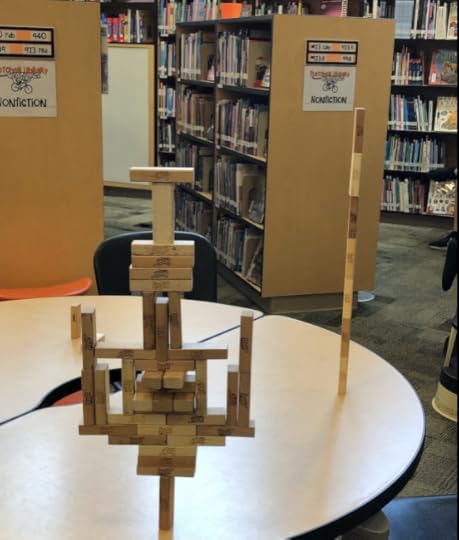 I am embarrassed to admit that I undertook this massive renovation of the nonfiction section without first stopping to take a Before Shot. But you can see our nonfiction section in the background of a casual shot I did take of a highly improbable Jenga structure one of my regular visitors made during lunch last March. As you can see, our nonfiction stacks were often densely packed with books, almost all of which were spine-out. Very librarian-friendly in that it allows for fast shelving, but not very student-centered. (Sculpture: Future Engineering Genius. Photo: Shala Howell)What would happen if I labeled the nonfiction shelves to call out important topics about teenage life?
I am embarrassed to admit that I undertook this massive renovation of the nonfiction section without first stopping to take a Before Shot. But you can see our nonfiction section in the background of a casual shot I did take of a highly improbable Jenga structure one of my regular visitors made during lunch last March. As you can see, our nonfiction stacks were often densely packed with books, almost all of which were spine-out. Very librarian-friendly in that it allows for fast shelving, but not very student-centered. (Sculpture: Future Engineering Genius. Photo: Shala Howell)What would happen if I labeled the nonfiction shelves to call out important topics about teenage life? My first attempts dealt with reworking the signage in the nonfiction section to highlight the sorts of topics that if I were a middle schooler I would want to read about but not ask an adult for help finding: mental illness, drug use, LGBTQ+ issues, puberty, divorce, grief, that sort of thing.
I wish I could claim to have come up with this idea all on my own, but the truth is, I got the idea from one of the librarians I follow on Twitter who posted a photo of her library’s Tough Topics list. It’s a sign that hangs in several places in their nonfiction section that tells patrons the Dewey Decimal numbers for topics they may be interested in, but are too embarrassed or simply reluctant to ask about.
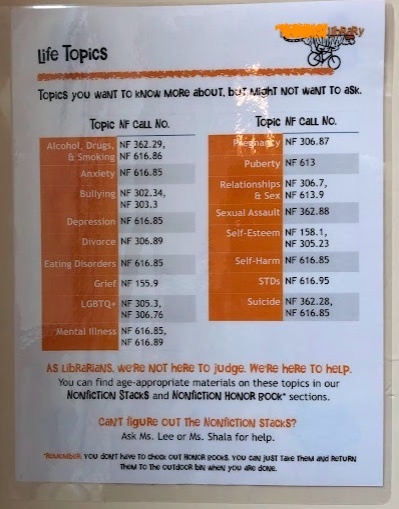 My Life Topics list, adapted for use in a middle school. (Sign/Photo: Shala Howell)
My Life Topics list, adapted for use in a middle school. (Sign/Photo: Shala Howell)I made one of these signs for us (relabeling it “Life Topics” on the advice of my Teacher Librarian) and placed a copy of it on the walls in Nonfiction and on my Book Recommendations Wall. I also made little orange shelf labels for each topic, which I stationed on the shelves themselves to highlight where the books for those topics lived.
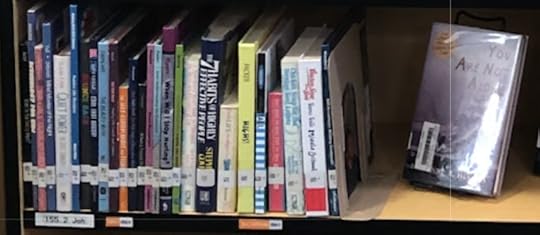 Sadly this photo is too poor a resolution for you to read them, but those orange and white shelf labels are my Life Topic labels. (Photo: Shala Howell, who probably needs a better camera)Did I see a boost in nonfiction circulation from all of this?
Sadly this photo is too poor a resolution for you to read them, but those orange and white shelf labels are my Life Topic labels. (Photo: Shala Howell, who probably needs a better camera)Did I see a boost in nonfiction circulation from all of this?Not really. But I did start seeing additional chaos in those portions of the shelves, which told me students were pulling the books, flipping through them, and placing them back in their-best-guess-for-the-right-spot.
Was that good enough for me to keep experimenting? You betcha.
But this post is already pretty long, so I’ll save the rest for next time.
Related Links: An end of the year library report and why it matters (Caterpickles)Racism in the Dewey Decimal System (Bookriot, Content Warning: Language)
July 2, 2022
Update to a Past Caterpickle: “Did dinosaurs have belly buttons?”
News broke this week of particular interest to us here at Caterpickles Central, because it touches on a ten-year-old question of ours: Did dinosaurs have belly buttons?
Ten years of life and a century’s worth of history* have passed since we first investigated this question here at Caterpickles, so I think a refresher is in order.
The Origins of the IssueIn 2012, I took my then five-year-old daughter on a trip to the Boston Museum of Science. While examining the skeleton of Cliff the Triceratops, she asked, “Mommyo, did dinosaurs have belly buttons?”
My first impulse was an instinctive, no. Belly buttons are a thing mammals have because a belly button is the scar the umbilical cord leaves when it drops off after birth.
But my daughter had learned by then that my medical knowledge is sadly incomplete, so she wanted to examine all of the evidence at hand before taking my word for it. Fortunately, we were in the museum’s dinosaur exhibit so there was a fair amount of evidence at hand to go through.
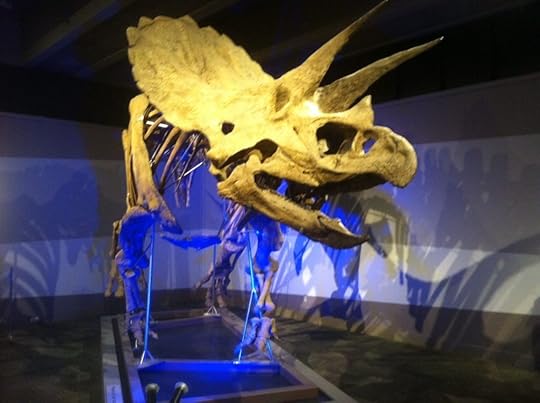 Cliff the Triceratops at the Boston Museum of Science may have inspired the question, but he was no help in answering it. (Photo: Shala Howell, 2012)
Cliff the Triceratops at the Boston Museum of Science may have inspired the question, but he was no help in answering it. (Photo: Shala Howell, 2012)I won’t relive the experience for you, but I will sum it up. After looking at the footprints, skeletons, and models available to us, we concluded reluctantly that what we really needed was a dinosaur mummy. The only one of those we knew about in 2012 was Leonardo, a mummified 77 million year old juvenile duck-billed dinosaur housed at the Phillips County Museum in Montana. At the time, I cold-heartedly refused to take The (then) Five-Year-Old there for our next Mommyo-Daughter play date.
Given the lack of readily available fossilized belly skin and my firm stand against The (then) Five-Year-Old’s proposal to set up an incubator in the guest bedroom to grow her own clutch of dinosaurs at home, we had no choice but to venture into the perilous field of comparative anatomy.
Feel free to read the past episode if you like (it’s one of our enduring favorites), but the upshot was that we decided that if dinosaurs had a belly button, it would have been like the scar baby birds have upon first hatching from their eggs. Those scars, which often fade over time, are what’s left of the connection between the developing bird embryo and its yolk sac.
Pending further investigation, we decided that newly hatched dinosaurs could also have had some version of a belly button, but that, like birds, a dinosaur’s belly button scar would have faded or disappeared altogether by the time they were full-grown.
“Further investigation” came three years later, when we had a chance to tour Dr. Paul Sereno’s lab at the University of ChicagoIn the fall of 2015, my daughter and I had the chance to tour Dr. Paul Sereno’s paleontology lab at the University of Chicago. He had all sorts of marvelous things in there, including a dinosaur mummy, complete with a long swatch of skin.
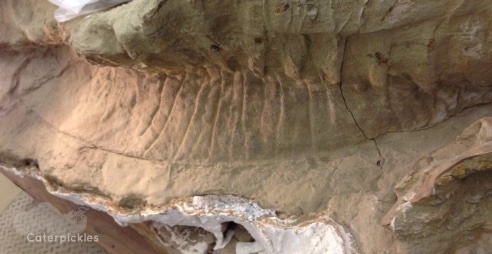 A portion of Dr. Sereno’s dinosaur mummy. There may be a dinosaur belly button here, but I can’t see it. (Photo: Shala Howell, Mummy: Dr. Paul Sereno & his team at University of Chicago)
A portion of Dr. Sereno’s dinosaur mummy. There may be a dinosaur belly button here, but I can’t see it. (Photo: Shala Howell, Mummy: Dr. Paul Sereno & his team at University of Chicago)Dr. Sereno was very excited about the potential that swatch raised for resolving the long-standing dispute about whether dinosaurs sported scales or skin, but my mind was buzzing with another question entirely.
I think you know what it was.
“Dr. Sereno, did dinosaurs have belly buttons?”
That’s right. Put me in a room with a world-famous paleontologist and I will have him talking about belly buttons faster than you can say Suchomimus.
In a testament to the effectiveness of what must have been hours and hours of absolutely grueling media training, Dr. Sereno managed not to laugh me out of his lab. He simply answered the question.
No. Belly buttons are a mammalian structure. They are the scar left when the umbilical cord that connected the fetus with the placenta during pregnancy detaches at birth. The scars baby birds have are a remnant of their connection to the yolk sac in its egg, but not true belly buttons. True belly buttons require a placenta, which creatures hatched via eggs never develop.
This week’s update: Paleontologist think some dinosaurs may have had the reptilian equivalent of a belly buttonThis week, news broke that scientists have discovered a Psittacosaurus fossil that sports a scar that they think is the reptilian version of a belly button. In case you, like me, had forgotten what a Psittacosaurus was, it’s an early member of the Ceratopsian family. Cliff the Triceratops, by the way, is also a Ceratopsian. It seems fitting that if Cliff couldn’t provide the answer to the question his skeleton inspired, that his great-great-great-…-great Uncle Psitty would.
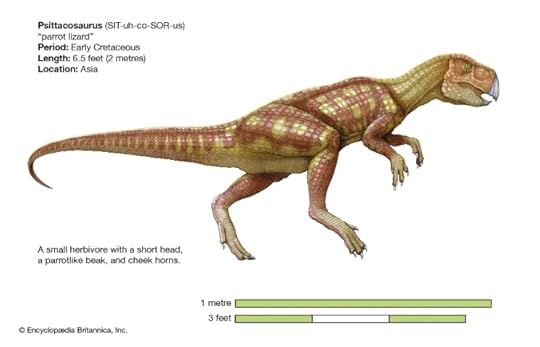 Artist’s illustration of Psittacosaurus, a mummified fossil of which appears to sport the dinosaur equivalent of a belly button. Although this dinosaur’s neck frill is so small I can’t see it in this image, I am assured by the Encyclopaedia Britannica writers that it is in fact there. Just as importantly, Psittacosaurus clearly has the all important upper beak bone, called a rostral, unique to the members of the Ceratopsian family. (Source: Psittacosaurus, Encyclopædia Britannica, last accessed June 23, 2022)
Artist’s illustration of Psittacosaurus, a mummified fossil of which appears to sport the dinosaur equivalent of a belly button. Although this dinosaur’s neck frill is so small I can’t see it in this image, I am assured by the Encyclopaedia Britannica writers that it is in fact there. Just as importantly, Psittacosaurus clearly has the all important upper beak bone, called a rostral, unique to the members of the Ceratopsian family. (Source: Psittacosaurus, Encyclopædia Britannica, last accessed June 23, 2022) After reading the Smithsonian article about the discovery, I no longer feel bad about not spotting the reptilian version of a belly button on Dr. Sereno’s mummy with my bare eyes. Dr. Phil Bell from University of New England and his team used a modified version of Laser-Stimulated Fluorescence (LSF) to spot changes in the pattern of the skin and scales that marked the umbilical scar. LSF uses intensified lasers to highlight fine details of each scale, wrinkle, and pattern on their Psittacosaurus mummy.
I do not have modified laser beams installed on my glasses, so of course I wouldn’t have spotted the umbilical scar while browsing Dr. Sereno’s fossil collection on a school tour. Of course, even if I could have spotted it, I likely wouldn’t have recognized it. I would have been looking for something round, like the belly button on a human child. The artist’s rendition of the belly button in the Smithsonian article reveals that a dinosaur’s umbilical scar would have been long and skinny.
Are we done now?Ten years on, can I finally treat this question as settled?
Ten years ago, my daughter and I decided that if dinosaurs had had belly buttons, they would have been structures similar to those found on baby birds. She was fine with that answer then. So fine she had forgotten that she’d ever asked the question in the first place when Dr. Sereno politely explained to me that belly buttons are not a thing reptiles have, technically speaking.
Nonetheless, if this new study is to be believed, it looks like our original supposition was close to correct. This dinosaur’s umbilical scar is more permanent than we had expected it to be, based on our baby bird model. And of course, as we learned from Dr. Sereno, a dinosaur belly button isn’t a true belly button like mammals have.
But, yes, some dinosaurs had the reptile equivalent of a belly button, and now paleontologists have a specimen and a paper proving it.
If any other paleontologists out there would like my daughter and me to speculate wildly and imaginatively on their area of expertise well in advance of the evidence, my comment field is open.
Related Links: Our original investigation: “Did dinosaurs have belly buttons?” (Caterpickles, 23 July 2012)Caterpickles asks the expert: “Dr. Paul Sereno, did dinosaurs have belly buttons?” (Caterpickles, 8 October 2015)The perils of comparative anatomy: “Why did they think the T. Rex stood with his tail on the ground?” (Caterpickles, 14 June 2011)First Dinosaur Belly Button Discovered in Fossil from China (Smithsonian, 13 June 2022)*It feels dissonant at best to post about something like this after the past few weeks, and I almost didn’t. I almost posted something about Dobbs, but in the end, decided to keep Caterpickles a politics-free zone. I want to keep Caterpickles a place where we can focus on our common interests, and put our differences on pause for a little while. I need a mental break from politics and fear-mongering, perhaps you do too.
June 18, 2022
An end of the year library report & why it matters
Since starting work in the middle school library, I’ve begun following basically every librarian I can find on Twitter. One of my more recent discoveries, Kelsey Bogan, tweets regularly (and maintains a blog!) about the various approaches she uses at her library to keep her students actively engaged and reading. Over the past few months, I’ve taken several of her ideas and tried them out in my school. (If you work in a library, and you’re on Twitter, I highly recommend following Kelsey. I’ve learned a ton about advocacy and boosting circulation from her this year.)
In late May, Kelsey tweeted about her one-page end of the year library report. She posted photos of the infographic in its digital form for sharing electronically with staff, students, and admin, as well as a photo of the infographic made up as a poster to display outside her library.
The teacher librarian at my school, Kristen, does an annual report every year for the administration and the district that describes the central role the library plays in our school community. Her report is very detailed, tailored to her audience, and an essential piece of advocacy, particularly when it comes to justifying budget requests.
But as a former marketer, I loved Kelsey’s idea of a simple one-page document that highlighted a few key facts that our community at large (students, parents, and teachers) would enjoy knowing, even if they didn’t know anything else about how the library functioned.
Many of Kelsey’s stats made sense to share with my community as well. Others I didn’t have enough experience as a first year library worker to speak to, so I either skipped them or swapped them out for ones that I suspected my audience would also be interested in. In this post, I’m going to talk about the 5 statistics I picked, why I picked them, and why I’m planning to keep doing this in the years to come.
Key Fact #1: How many books were used this year?The first question most people ask when they’re trying to figure out whether a library is being used is how many books were circulated in a given year.
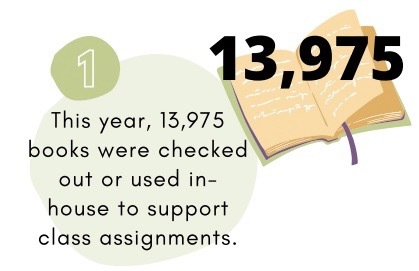 This year 13,975 books were checked out, read by students relaxing in the library between classes, or used by a class to support various research assignments. For context, we started the year with 530 students and have just under 15,000 books in our collection. (Poster design: Canva, Content: Shala Howell)
This year 13,975 books were checked out, read by students relaxing in the library between classes, or used by a class to support various research assignments. For context, we started the year with 530 students and have just under 15,000 books in our collection. (Poster design: Canva, Content: Shala Howell)In her EOY report, Kelsey includes circulation numbers for every year since 2016-2017. I chose to simply report this year’s total for a few reasons.
The first is that I wanted to include books used in-house in my total circulation statistics to get a more complete picture of how our collection is being used. This is the first year we have ever routinely tracked books used in the library. In the past, the library assistants simply tracked books that left the library (check-outs). I changed that this year because we have a large nonfiction weed coming up. Although we do have some students who read nonfiction on their own, by far the largest usage of our nonfiction section is to support class-driven research projects. Before we weed, we needed to be able to tell which books in our nonfiction section were still relevant to the school’s curriculum as it is currently being taught. Logging a book as used in-house whenever we pull books for a given class is a simple way to document that.
And yes, I know, I could simply exclude books used in-house from my circulation numbers, but that doesn’t solve the other problem. In 2016-2017, our student enrollment was 726. We started the 2021-2022 school year with 530 students. Comparing top line circulation numbers without providing that context is deeply misleading at best.
Kristen and I discussed the possibility of creating a chart that compared per-student reading numbers that would take into account enrollment changes. But we decided to go with just the top line number this year for simplicity’s sake. As a nice bonus, it gave us a design element for our one-pager that *wasn’t* a graph or pie chart.
Key Fact #2: What was the most popular book this year?Over the year, I’ve learned that the easiest way to sell a student on reading a book is to point out that lots of their classmates have also read that book. Oddly, students aren’t as interested in whether Kristen and I read the book and liked it. Often, the single most powerful argument I can make in favor of a book is “I haven’t read this yet, but I’ve noticed that it is constantly being checked out.” So as soon as I saw that Kelsey had listed the year’s most popular books on her report, I knew I needed to include it on my report as well.
Kelsey had a tie for most popular book in her library, but in ours it was far and away Scythe by Neal Schusterman.
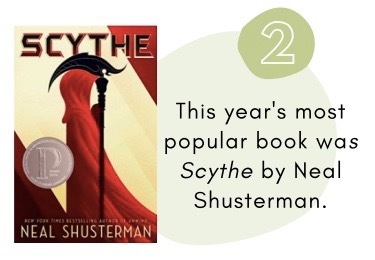 Dystopian novel about apprentice Grim Reapers run amok? Sign our kids up. (Poster design: Canva, Scythe book cover: Kevin Tong, Words: Shala Howell)Key Fact #3: The number of books checked out through our Hold Shelf
Dystopian novel about apprentice Grim Reapers run amok? Sign our kids up. (Poster design: Canva, Scythe book cover: Kevin Tong, Words: Shala Howell)Key Fact #3: The number of books checked out through our Hold ShelfI’ll be honest. I did this one for me. During the remote schooling phase of the pandemic, Kristen and her then Library Assistant spent a lot of time and effort training students to reserve books online and come pick them up using the library’s curbside pickup and drop-off service. Circulation numbers weren’t great last year, but there was a core group of students who used this service every week.
I was curious to see if there was real interest in a curbside dropoff and pickup like service once we were back in person. So I introduced a new Hold Shelf like the one offered by our local public library for students who preferred to — or only had time to — use our library that way. When it came time to do this report, I wanted to know whether that Hold Shelf was worth continuing.
Our library software tracks reserves, so figuring this out basically entailed asking the question. It turns out students reserved 730 books through that shelf.
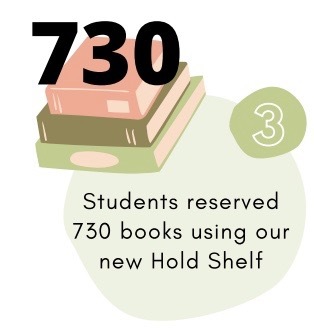 Our Hold Shelf was a new addition in 2021-2022. Doing the end-of-year report gave me a chance to assess whether it was worth keeping. (Poster design: Canva, Content: Shala Howell)
Our Hold Shelf was a new addition in 2021-2022. Doing the end-of-year report gave me a chance to assess whether it was worth keeping. (Poster design: Canva, Content: Shala Howell)That doesn’t sound like much, but when you realize that the 730 books that passed through the Hold Shelf represent roughly 8% of the physical materials checked out in 2021-2022, it starts to look more valuable. I would be interested to know what percentage of physical checkouts pass through the Hold Shelf at the public library, but that’s just sheer curiosity on my part.
At its current usage level, maintaining the Hold Shelf requires somewhere between 10-20 minutes of my time a day. In that time, I check the library software system for new reserves, retrieve the books from the stacks, print the reserve slips, stash the books on the shelf according to the student’s last name, and message the students that their books are ready. On Thursdays I’ll make a Reserve List sign to post outside the library listing the students who have books on hold and reminding them to come pick up their books before the weekend. On Monday mornings, I go through the Hold Shelf, and pull books with expired Holds and return them to circulation.
In exchange, I’ve noticed the students using that shelf in all kinds of unexpected ways. The most common use, of course, is the expected one: to join the waiting list to read popular books like Crush by Svetlana Chmakova or Six of Crows by Leigh Bardugo. Students also use it to reserve what I think of as overflow books, the next one or two books they want to read, once they’ve finished reading the books they have already checked out. I also have several students who use the Hold Shelf to stash books that they only want to read in the library for whatever reason.
Interestingly, I’ve noticed that some of our heaviest Hold Shelf users are students who frequently or almost exclusively read nonfiction. I may be reading too much into that, but I can’t help but wonder if that means that the Hold Shelf has a role to play in making our nonfiction section feel more accessible to readers. If true, that fact alone is enough to convince me to keep it. Over the year, several students who were initially described privately to me as reluctant readers revealed themselves to be dedicated nonfiction readers who simply needed to be shown how and/or where to find nonfiction books on the topics they were interested in.
Key Fact #4: Which grade checked out the most books?Kelsey also had this stat on her list. I can’t speak to her reasons, but in our case, it’s extremely useful. Our students are a competitive bunch, and a stat like this could easily encourage more checkouts next year.
This year, we had a mixed result. Sixth graders checked out the most print materials, but when you include ebooks, the seventh graders checked out more books overall. Sadly, the 8th graders aren’t reading nearly as much as the other classes. Perhaps we could figure out why and do some targeted interventions for 8th graders next year.
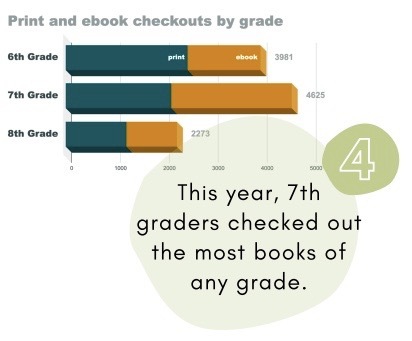 Checkouts by class. These numbers don’t include items used in-house, so won’t add up to our total circulation. (Poster design: Canva, Content: Shala Howell)Key Fact #5: What percentage of our fiction checkouts were of diverse books?
Checkouts by class. These numbers don’t include items used in-house, so won’t add up to our total circulation. (Poster design: Canva, Content: Shala Howell)Key Fact #5: What percentage of our fiction checkouts were of diverse books? Reading builds empathy. In order for that little trick to work, students need ready access to books that reflect their experiences (mirrors) and give them insight into the lives of other people not exactly like themselves (windows).
At my school, we serve a diverse mix of students from a wide range of economic and cultural backgrounds. Our district is currently auditing all of its school library collections to ensure that students have plenty of books that serve as both mirrors and windows. (Kelsey has a great post on her blog where she talks about how librarians who don’t have time to do a full diversity audit can reap most of the benefits of one with a fraction of the work.)
Curating the collection to include books that reflect our student’s experiences and build empathy toward others is important, but it’s only the first step. We also need our students to read those books.
This year, we invested a lot of time promoting a wide range of diverse books through bulletin boards, genre posters, reading lists, one-on-one conversations, front-facing books on our fiction and biography stacks, and topic-specific seasonal displays. We took a hard look at our series section, and swapped out some older series that were no longer being read with newer series from BIPOC or LGBTQ+ writers that could benefit from the added attention. Each month, I created a Google slides presentation highlighting select books from our new acquisitions, and ran it on a continuous loop on the TV mounted on the wall behind the circulation desk.
When I saw that Kelsey had included a statistic for the percentage of her checkouts that were diverse books, I decided that stat would be a good way to see if those efforts were having an effect.
I cannot tell a lie, that statistic took HOURS to compile. Although every book in our collection is tagged for easy searching of similar books, as far as I can tell, our library software doesn’t automatically include those tags in its circulation/checkout reports. I had to compile that information by hand. If I want to keep including this stat in the future, I have got to figure out an easier way.
Regardless, assuming I did all of that manual work correctly, at least 40% of the fiction books checked out from our library this year were either written by or featured main characters who were BIPOC, LGBTQ+, neurodiverse, or have physical differences. A good start.
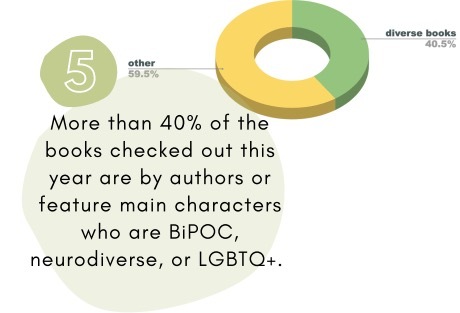 Final snippet from my one-pager shows the percentage of our fiction checkouts that are diverse books. (Poster design: Canva, Content: Shala Howell)Why spend all this time pulling together statistics for a one-page document that folks will skim in about 45 seconds?
Final snippet from my one-pager shows the percentage of our fiction checkouts that are diverse books. (Poster design: Canva, Content: Shala Howell)Why spend all this time pulling together statistics for a one-page document that folks will skim in about 45 seconds?I mean, Kristen puts all of this and more in her annual report right?
In my district, staffing and library resources are determined by enrollment. This is great when enrollment is rising, but enrollments are dropping across California. Our school, which is sized for more than 700 students, had a mere 530 students at the beginning of this past school year.
As regular readers know, I lived in Chicago before moving to California, and there I witnessed school library after school library being shuttered due to budget cuts. So far, that doesn’t feel like it’s on the table for our district, but at the same time there is dire talk around “adjusting library staffing to better align with enrollment.” Unfortunately, in practice this means that smaller schools in the district like ours will have relatively small staffs, and as a result, will be able to offer fewer library and other support services. And that means students zoned to attend those smaller schools will have less access to important reading, critical thinking, and research support due to circumstances entirely outside of their control.
You can see how this quickly becomes an equity issue. If you happen to live in an area zoned for one of our district’s smaller schools and your school’s staffing is cut to match enrollment, you will inevitably end up having less access to educational support services than other students in that same school district who happen to live in a neighborhood zoned for a larger school.
In this environment, it feels more urgent than ever to advocate for the library, its programs, and the staffing to support those programs to as many groups as possible in as many ways as possible. In an ideal world, funding and staffing would be decoupled from enrollment to some extent so that we can continue to provide critical library and reading support services in as equitable a fashion as possible.
Kristen’s annual report is designed for our administration and central district office to justify our annual budget, account for our expenditures, and to document the programs and activities driven through the library each year. It’s an essential piece of documentation, and well-targeted for its specific audience.
My one-page flyer was originally intended to entertain the students and partially compensate for the fact that the library itself was closed and they didn’t have access to the thing they really wanted … the books, the games, and the comfy chairs.
But it quickly became evident that there was a much larger audience for it. In the end, my one-pager with its 5 simple facts was posted outside the library for the students and other passers-by, emailed to the teachers and administration at our school, tucked in with Kristen’s annual report to the district central office, and emailed out to the parents in the final school e-newsletter of the year.
And, although we didn’t specifically send it to him, within 24 hours a copy of our fact sheet and annual report ended up in the hands of our district superintendent. That was pretty awesome, but also speaks to the clear need for school libraries to do this sort of facts-at-a-glance advocacy for themselves and their program.
Thank you, Kelsey, for the idea!
Related Links:
Mirrors, Windows, and Doors (Rudine Sims Bishop)Kelsey Bogan’s Twitter feed and her blog, Don’t Shush MeInformation Literacy Lost: Most CPS schools no longer have librarians (Chicago Tribune)June 11, 2022
Hello, summer!
Hello, friends! It’s summer and at last I’m back. I have all kinds of thoughts on how my first year working in a library went that I can’t wait to share with you in the coming weeks, but first, let’s just enjoy the fact that as of 4 p.m. yesterday I am officially on summer break!
The scoop from our backyard The drought in our area continues to worsen, so instead of growing a vegetable garden this year, I am simply maintaining my succulents. They are rewarding me with all sorts of surprises, like these flowers. Who knew that would happen? (Photo: Shala Howell)
The drought in our area continues to worsen, so instead of growing a vegetable garden this year, I am simply maintaining my succulents. They are rewarding me with all sorts of surprises, like these flowers. Who knew that would happen? (Photo: Shala Howell)The last time we chatted, my backyard was leaning into its side gig as an urban wildlife refuge. The rabbits, squirrels (black, grey, and ground), the opossum, various and sundry neighborhood birds, and the adult male duck are all doing fine and enjoying varying degrees of welcome from the Howell family in general.
The ducklings, unfortunately, are no longer with us and haven’t been for some time. The 24 hours after my last post was… not great. If I’d known at the time that the average duckling survival rate is anywhere from less than 10% to as high as 70%, I probably wouldn’t have let any of us get quite so attached. Unfortunately, we here at Caterpickles Central had a front row seat to what a less than 10% survival rate looks like. After the last of her ducklings disappeared, our deeply unlucky mother duck spent a few very depressing days moping in our backyard, before taking herself off somewhere else. We haven’t seen her since.
The news from indoorsSomehow, my daughter is now fifteen and on track to be a sophomore in high school next year. That’s… astounding. We are going to have to start teaching her to drive soon. No, let me rephrase. Michael is going to have to start teaching her to drive soon. I think we can all agree that it’s best if I don’t do it.
In other news, I have loved my first year working in the middle school library. I’ve applied and been accepted to San Jose State University to get my masters in library science. Classes start August 1. I’m currently planning to continue working in the library while I work on my masters, so I guess next year’s posts will be full of self-reflection on whether my new lifestyle is actually sustainable. But for now, let’s just enjoy the fact that I’m getting to go back to school in the fall, and somehow won’t be the oldest person there.
 Me, standing outside Boyce Gate at San Jose State University in San Jose, California. (Photo: Michael Howell)
Me, standing outside Boyce Gate at San Jose State University in San Jose, California. (Photo: Michael Howell)In the meantime, my plans for the summer include lots of writing both here on Caterpickles and on some works-in-progress that I set aside during the school year, lots of decluttering, some exploratory baking/cooking, and of course, a ton of just-for-me reading while I still have time do it.
See you around the blog,
~Shala
April 6, 2022
It’s spring break, and you know what that means…
I am not going to lie. I am so tired. 2022, like 2021, 2020, and 2019 before it, has been a lot. Between Omicron, the war in Ukraine, the worrying trend toward book banning sweeping various states, some difficult events in our extended circle of family and friends, and how much has been going on at school lately, I am just tired. Fine, more or less, thankfully. But emotionally exhausted and in the market for a distraction. You may be too. So in that spirit, and not intending to downplay anything you may be feeling in response to events in your own life, I offer this update from the mini-wildlife refuge we call a backyard.
Fortunately, because it’s spring, we have quite a lot of breaking news happening out there. My daughter reports that we have another opossum, the backyard smells as if the skunk has finally moved away (or simply gotten used to us wandering about), the rabbit family has had another set of kits, and Mama Duck has hatched ten fluffy new ducklings in a nest under our palm tree. The ducks and the ducklings are getting the most attention, as Mama Duck is very busy right now teaching her ducklings how to swim and forage. Also, she tends to do this in the daytime, when we’re able to see her.
I know I ought to care about the mess this is going to create, but those ducklings are so flipping cute all the time the mess just doesn’t feel important. I expect in about six weeks when I’ve got eleven basically full-grown ducks in my backyard, I’ll have a different opinion.
But I’ll also feel much less bad about chasing them off when those ducklings are able to fly and stand a reasonable chance of surviving without Mama Duck. For now, I’m just going to bask in the cuteness.
Which is why this spring break, you’ll find me spending most of my time sitting by a window where I can watch the baby ducks learn to swim and dive and waddle about in a Line of Exceptional Cuteness.
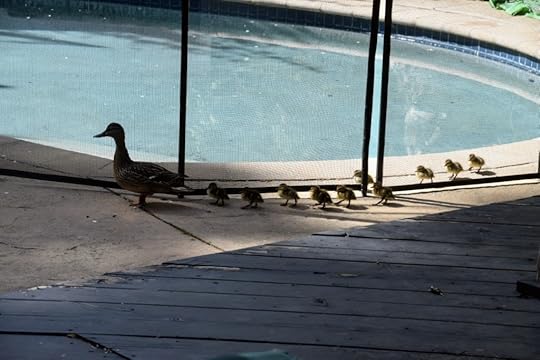 Make way for ducklings. (Photo: Michael Howell)Those ducklings have a lot to learn in two months, and Mama Duck isn’t wasting a moment of it.
Make way for ducklings. (Photo: Michael Howell)Those ducklings have a lot to learn in two months, and Mama Duck isn’t wasting a moment of it. It’s been fascinating watching the lessons (and skills) progress.
Sunday’s lesson was simply “Getting in and out of the Pool.” Getting in worked great. Getting out was clearly a problem. Mama Duck can simply hop out. Her ducklings tried, but were simply too small to do it Mama’s way. I’ve since learned that the first thing a Mama Duck does after her ducklings have dried off from hatching is lead them to water. It’s entirely possible that Sunday’s swim was their first field trip on their very first day. No wonder they couldn’t just hop out Mama-style.
Fortunately, we already had a Frog Log Critter Escape Ramp installed in our pool to help critters that fall in climb out before they drown. Eventually Mama Duck remembered that and led her ducklings to it. Thank goodness she did. I shudder to think how that lesson would have ended if she hadn’t.
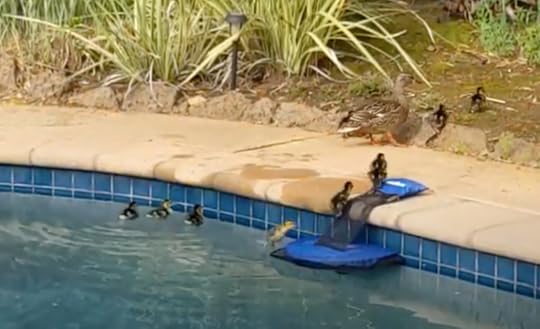 The ducklings took a little while to figure out how to use the ramp, but now they charge up it like champs. (Photo: Michael Howell)
The ducklings took a little while to figure out how to use the ramp, but now they charge up it like champs. (Photo: Michael Howell)Monday’s lesson was “Diving off Relatively High Places.” We have two levels of pool edge, the low one that you see in the photo above, and a higher retaining wall by the side garden. The ledge on top of that retaining wall was the relatively high place Mama Duck picked for Monday’s lesson. That was absolutely adorable. Most of the ducklings were very brave. A few needed extra encouragement from Mama and their siblings.
Yesterday, the ducklings appear to be learning the timeless classics “Sleeping while Floating” and “Sleeping on Land While Other Ducks Are Floating.”
I cannot wait to see what the lesson is today.
Ducks are surprisingly fascinating creatures.Did you know that when it’s time for a land nap, Mama Duck gathers all the ducklings underneath her? Look closely at this photo and you’ll see the some of her ducklings carefully tucked under her belly.
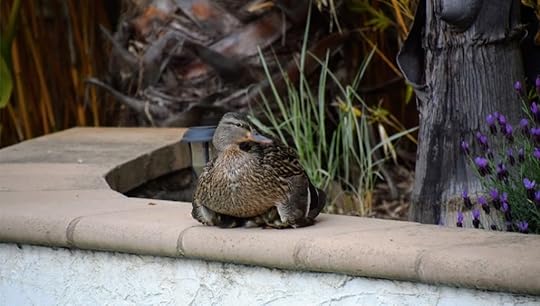 Mama Mallard sitting on a ledge in our back garden, with all ten ducklings safely tucked away for a mid-afternoon nap. (Photo: Michael Howell)
Mama Mallard sitting on a ledge in our back garden, with all ten ducklings safely tucked away for a mid-afternoon nap. (Photo: Michael Howell)Apparently, Mama Duck broods like this because while all that yellow fluff is cute, it’s not waterproof or particularly warm. For the first few days of life, the ducklings huddle up under Mama to get (and stay) warm.
There is also a fair bit of family dramaYesterday, Mama Duck flew off for a bit, which was pretty worrisome for everyone in the house, except for our cat, who lobbied loudly to be allowed to take advantage of this rare opportunity (don’t worry, he’s still an indoor only cat).
Eventually Mama Duck came home, with a male mallard close behind her. At first I thought, “Ah, how cute, Papa Duck is here to help out.” And then I noticed how very upset and full of duck curses Mama Duck was.
That’s how I learned that male mallards may help with the nest choosing, but they most definitely do not help with the duck raising. Mama Duck does that all on her own. In fact, Mama Duck was pretty upset when Papa Duck started poking about because (as I’ve since learned) male ducks can be dangerous for her ducklings. They don’t eat them, as far as I can tell, but they will kill them.
Brutal.
Mama Duck chased off Mr. Mallard on her own yesterday, but he came back with two of his drinking buddies this morning. Mama Duck defended her nest ably, but after she’d forced Mr. Mallard and his buddies to retreat to the pool to regroup, I strolled out casually with my morning coffee. Thankfully, that was enough to get those rogues to fly off and leave Mama Duck and her brood in peace.
Since then, I’ve done the odd bit of reading about how to deal with a duck family in your backyard. While I don’t regret chasing off those rogue mallards this morning, I have since learned that it’s a very lucky thing that I didn’t chase off Mama Duck as well. Mama Ducks have been known to abandon their young in the presence of sufficiently alarming humans.
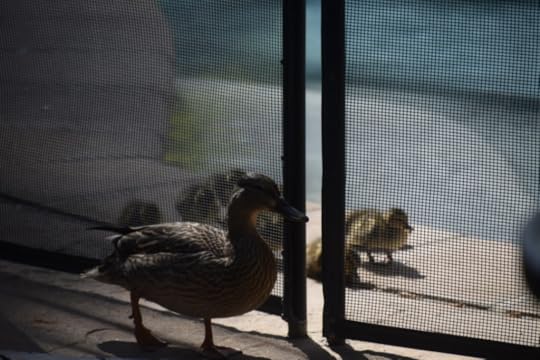 We have a fence around our pool, and Mama Duck spends a lot of time patrolling its perimeter while her ducklings are on the inside. Michael was trying to think what this reminded him of, and then it struck him: “It’s the duck version of a Pack-n-Play, Shala.” (Photo: Michael Howell)So, what do you do if you find a family of ducks in your backyard?
We have a fence around our pool, and Mama Duck spends a lot of time patrolling its perimeter while her ducklings are on the inside. Michael was trying to think what this reminded him of, and then it struck him: “It’s the duck version of a Pack-n-Play, Shala.” (Photo: Michael Howell)So, what do you do if you find a family of ducks in your backyard?According to this Mercury News article, if you find yourself with a family of ducks in your backyard, your best bet is to leave them alone, don’t feed them, and only interfere if an especially dangerous predator comes along. Presumably, the category of “exceptionally dangerous predators” does not include Mr. Mallard, as Mama Duck appears to be quite capable of dealing with rogue ducks on her own. It does, however, include your pool drain and pool sweep. So keep an eye on that stuff. It’s also a good idea to install a critter escape ramp in your pool, if you don’t already have one and if you can do it without freaking Mama Duck out. We use the Frog Log Critter Escape Ramp, but there are lots of similar products available on Amazon, and I imagine, at your local pool supply store.
When the ducklings are grown (in about two months), the entire family ought to move away. So I guess we’ll just sit tight and enjoy the show until then (and plan to clean up after).
I had been hoping to do a little light gardening over Spring Break, but I really don’t want to end up nursing a of baby ducks for two months if Mama Duck moves out in a panic, so I guess this spring’s herb garden and cactus refresh will just have to wait. Although truthfully, if despite our best efforts to be non-threatening, we end up scaring Mama Duck away, we’ll just call a local wildlife rehabilitator. Raising wild ducklings is just simply not a thing I’m equipped to do. Still, probably best for everyone if I let the garden wait.
So, how are things where you are? Any news from your backyard? Related Links: The Life of a Duckling (Royal Society for the Preservation of Birds) (The Spruce)Help! There’s a Mallard Laying Eggs in Our Backyard (Mercury News)There’s an opossum in my yard. Is it time to freak out? (Caterpickles)There’s a mouse in my pool. Is it time to freak out? (Caterpickles)Who ate my lettuce? A Caterpickles Investigative Report (Caterpickles)January 18, 2022
Update: Middle school library life in these Omicron times
First of all, please accept my apologies for the long radio silence, and my thanks for still coming to visit my little blog while I’ve been off doing other things.
Happy New Year, by the way.
I hope 2022 treats you as gently as possible.
I am still figuring out this work-life-writing gig. Back in September, I tried writing on Saturday mornings, but it turns out I really need to have a time in the week where I don’t have to do very much, and Saturday mornings before everyone else is up are tailor made for that.
In giving myself Saturday mornings to do whatever, I promised myself that I’d catch up on writing over school holidays. But at Thanksgiving, things had gotten better enough pandemic-wise that we could go visit my family in Dallas for the first time in two years, so of course we chose to do that.
Things were still good enough at the early part of Winter Break for us to take our first family vacation in more than two years, so of course we chose to do that too.
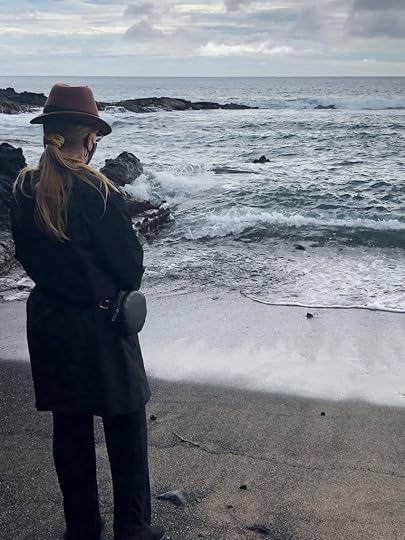 The now 14-Year-Old standing on a beach in Maui in December 2021. (Photo: Shala Howell)
The now 14-Year-Old standing on a beach in Maui in December 2021. (Photo: Shala Howell)Both were great, and I have few regrets.
So, what’s it like to work in a school right now?If I were you, I’d be really curious to know what it’s like to work in a school library during Omicron. Before I continue, I want to set the stage.
I am so fortunate to be working in a school district that has put a number of safety measures in place:
Vaccine mandates for staff, substitutes, and volunteersMask mandates for everyone on campus (enforced & almost universally complied with)Surgical masks available in student and adult sizes in the library and in the office for students & staff who need a fresh mask for whatever reasonSo many hand-washing & hand sanitizing stationsVentilation upgrades in classrooms, the library, the gym, and all shared indoor spacesA permanent substitute on site who swaps in for teachers as needed to ease staff shortagesLunch is served inside, but it is eaten outside (yay, California!)Portable chairs for teachers and staff, courtesy of the PTA, to make it easy for us to eat safely outside as wellBand and choir classes held outsideFree weekly testing on-site along with free daily testing Monday – Friday at a former high school turned community center for all staff and studentsIn addition, we have both a school nurse and multiple school counselors with predictable, regular hours. They weren’t hired just for Covid, but they have been invaluable as we navigate these Covid times.
I can rattle off these things so easily because I have spent the week reminding myself of them as Omicron rages on.
The reason I have been rattling them off so frequently is because our superintendent has vowed to keep our schools open unless the county forces them to close or so many of us get sick that staffing simply isn’t possible any more. That’s hard for someone like me, who spent almost two years fully huddled up, to process without a constant reminder of all the things the district has done to earn the right to try to keep schools open throughout the Omicron wave.
And in truth, these measures worked great last fall. The week we left for Winter Break we had something like a dozen cases across the entire district. The first week we returned from Winter Break, that number had increased to 382 cases district-wide.
Of course, many of those cases resulted from exposures over the holidays, but school doesn’t happen in a vacuum. Those community-acquired cases ripple into schools through staff and student absences, and new exposures at school from people who didn’t realize they had Covid yet. And yes, I know from Twitter that this is a tiny number compared to what some districts are enduring.
Still, it’s having an impact.
What does this mean in practical terms?Sure we’ve been wearing masks, eating outside, leaving the doors and windows open, and asking our substitutes and volunteers to prove their vaccination status before coming on campus all year, but now for the first time, it feels like I’m working at a school during a raging pandemic. (Keep in mind, this is my first year, so those Covid restrictions that were a big change for everyone else were just the way school worked to me.)
Because local case rates are so high right now (264 cases per 100K people), our superintendent has asked staff to behave as if they have been or will be exposed every day they report to work. The district has stopped sending out contact notices because so many people have Covid everyone would get a contact notice every single day. This, combined with the staff and student absences, has not been a calming message. Still, if you are determined to do everything possible to keep schools open during the Omicron spike, telling everyone to assume that they will be exposed and to take whatever steps they feel necessary to mitigate that exposure in advance, seems like the only remaining option.
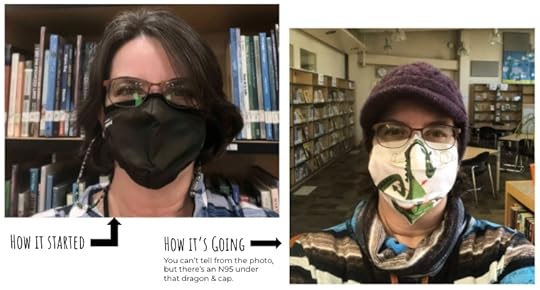 When Omicron hit, I had to make a few upgrades. Instead of a comfy cloth mask, I’m wearing an N95 that loops around the back of my head. I’ve covered it with a fun but purely decorative dragon cloth mask, and am wearing a cap to hide the N95 straps, which frankly don’t play well with my haircut. I don’t know if you can tell from this photo, but that dragon is reading a book. I’m also testing twice a week now, instead of just once. (Photos: Shala Howell, August 2021 – left, January 2022 – right)
When Omicron hit, I had to make a few upgrades. Instead of a comfy cloth mask, I’m wearing an N95 that loops around the back of my head. I’ve covered it with a fun but purely decorative dragon cloth mask, and am wearing a cap to hide the N95 straps, which frankly don’t play well with my haircut. I don’t know if you can tell from this photo, but that dragon is reading a book. I’m also testing twice a week now, instead of just once. (Photos: Shala Howell, August 2021 – left, January 2022 – right)That first week back, my husband made me a Corsi-Rosenthal box out of a box fan and five Merv 13 air filters to keep at the circulation desk for some high-intensity air filtration in the section of the library that gets the most traffic and where I happen to spend most of my time. It’s been in the library chugging away all week. So far, none of the students have expressed any curiosity at all about it, which frankly, is pretty weird. Usually I get 12 questions a day about minor changes in the library. That thing is massive and made from love and duct tape, so I would have expected more questions about it. I’m going to add giant googly eyes to it this week to see if that helps.
Everyone on campus is walking around in winter hats and coats, because anyone who can open their doors or windows does, and no one likes being cold. Again, we’re lucky we are in California and can open our windows in winter without freezing the school’s pipes.
Like me, at least half of the student body and staff have upgraded their masks in some way. By far the most common switch has been from cloth to surgical or KN95 masks, although a few have started double-masking (cloth over surgical, mostly).
What’s attendance been like?At our school alone, a dozen teachers were out that first week in January, including my fellow librarian. For context, this is roughly 15-20% of our faculty. Attendance is down among the student body, too. Informally, my daughter reports that lunch lines at the high school, which used to be horrendous, are nearly non-existent. About 20% of the students in her classes are absent on any given day. So far, none of her teachers have been out.
I don’t really have insight into class attendance or the lunch lines at my middle school, since I’m just in the library and don’t float around campus. But I have noticed that our crowds before school and at lunch are roughly 25% smaller. The students who do come are much more subdued and anxious.
I’ve been getting emails from worried patrons kept at home unexpectedly for Covid restrictions, telling me about books they can’t return on time, clearly fretting that I’ll somehow hold this against them. More and more students are using my Hold Shelf to keep their books in between bouts of reading at the library instead of checking them out, because they are worried that they, like their fellows, will be abruptly placed in isolation and don’t want to have to deal with keeping track of their library books on top of everything else. Students who used to come to read have gravitated to finding quiet spots by themselves to stare out windows or write in their journals. The Rubik’s cubes have remained popular, but instead of grabbing the oddball Pyramid and sphere-shaped Rubik’s cubes first, the students are competing to get the much more familiar 3x3s.
How long will this last?I don’t know what I’ll find when I wander back to school this morning. Were the absences those first two weeks a post-holiday aberration? Will the four days we’ve had off for MLK day be enough of a fire break to tamp transmission? Or are we in a surge that is going to last for a while?
It’s hard to tell. The district only reports numbers once a week, and only includes cases that they can trace directly back to an exposure at school, so the numbers on their dashboard don’t necessarily correspond to what we are seeing at school. Yes, I can understand why the district would focus on tracking case spread at school, but all those folks who acquired Covid from some other part of their life are still absent. And the result is that I’m left trying to piece together what’s happening at the school through shared anecdotes of what other staff members see in their small slice of it.
I can tell you that the superintendent put out a call for parent volunteers to provide emergency supplemental staffing. A small army of parents were on campus late last week getting a tour and brief training on the various jobs we would need them to do. I know, because one of those jobs is for the library, so I got to meet some of them. As my daughter would say, I have two feelings about this. I am so very grateful that they are there, and so sorry that we need them.
Still life must go onThis week we’re judging our Winter Writing Contest. Several students have asked me for personalized feedback on their stories after the contest is over, which makes me happy.
We are also kickstarting our annual reading marathon (Book-a-thon), where teachers and staff donate prizes that we raffle off to students who read at least one book between mid-January and mid-March.
It’s also time for me to make a new set of genre-bending book recommendation lists based on the book requests I get from students at the library (“I’m looking for a funny but dramatic book, Ms. Shala. What should I read?” “I’m looking for an LGBTQ+ book, but one that’s about normal everyday life stuff, not fantasy or paranormal adventures.” “I’m looking for a historical fiction book, but with real people.”)
In other news, our Sponsor-A-Book fundraiser before Winter Break was wildly successful, with parents signing up to sponsor about two-thirds of the books on our 100+ long wish list. Parents are amazing, and I love them. Supply chain issues in the book manufacturing world are real, though, and although we placed our Sponsor-A-Book order back in mid-December, it could easily be mid-March at the earliest before it comes in. Still, new books! Yay! (Eventually.)
What about you?Are your schools open? What are you seeing / experiencing? I would love to hear how things are going in your part of the country, if you have time and/or the inclination to tell me.
Until next time, as always, thank you for reading. I hope you are (and remain) as well as can be expected.
– Shala
Related Links:
PAUSD’s Covid-19 Dashboard (Palo Alto Unified School District)Build your own Corsi-Rosenthal box (Clean Air Crew)Palo Alto Unified asking parents to fill support staff positions stretched thin during pandemic (ABC News)November 11, 2021
Guess who was not prepared for how hard it would be to juggle a job and home life?
This girl.
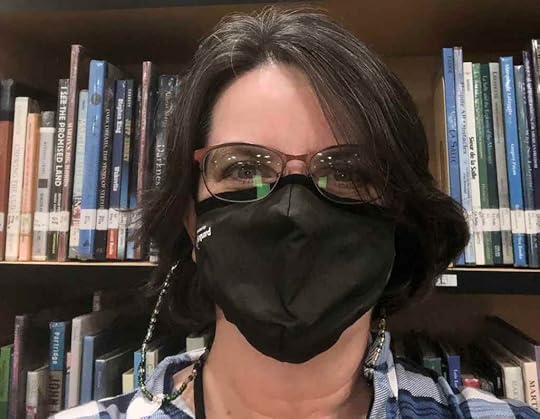 Me, that first week, before the students even arrived. Look how excited my eyes are. (Photo: Shala Howell)
Me, that first week, before the students even arrived. Look how excited my eyes are. (Photo: Shala Howell)As you may have noticed, I have not been posting much here at Caterpickles lately. My job is amazing, and I love working with both middle schoolers and books, but I do have a tendency to use up all my words at work. But y’all have been remarkably faithful about continuing to visit my little blog, so since we have a day off today, I thought I’d spent at least part of it telling you how things have been going.
Happy Veteran’s Day, by the way.
Many of the teachers tell me that this year is pretty weird. I don’t really have context for that, but I can tell you that the library is operating a little differently this year.
We added a new Holds ShelfIf your public library is like my public library, this is not going to seem like an innovation to you. After all, public libraries have allowed patrons to reserve books online and come pick them up at their convenience for years.
But it never made sense to implement it at my middle school, because the kids could come in whenever they wanted. About a hundred kids pass through the Fletcher Library every day. We get plenty of foot traffic, and in the Before Times, it worked perfectly well to have the kids come fetch their own book.
Then COVID happened.
Last year, because the school was closed to in-person learning for most of the year, the kids got pretty used to reserving their books online and picking them up during curbside pickup on Wednesday morning. The librarians spent a lot of time training the kids to do this last year. When school resumed in person this year, we considered going back to life as usual.
But then some of our best readers told us they really liked the convenience of curbside pickup, because they don’t always have time to browse for books during the school day.
And it really had been quite a lot of work to teach them to use our website. In the end, rather than toss all that work aside, we decided to create a new Hold Shelf in our library, similar to the one the public library uses.
The kids request books online, I fetch the books from the stacks, reserve them in the system, pop them on the shelf, and email the students to come pick them up. Most of the kids are pretty good about checking their email, but some never do, so I also post a sign at the door on Thursdays to remind kids to pick up their books before the weekend.
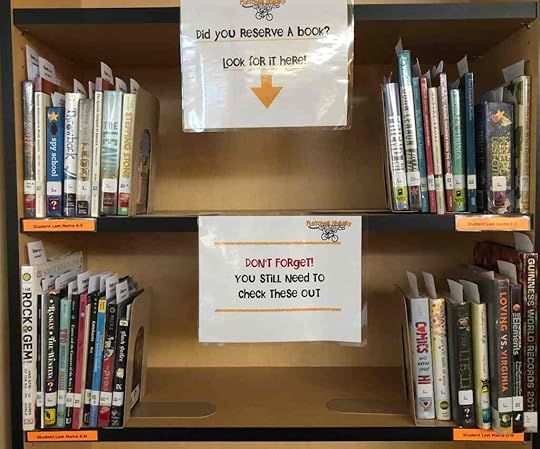 Our Hold Shelf on a typical afternoon. It doesn’t see a ton of traffic — on average only about 100 of the 2000+ books we check out each month pass through the Holds Shelf — but it gets fairly steady use and it gets books into the hands of kids who would otherwise never use our library, so I’m pretty happy with it. (Photo: Shala Howell)
Our Hold Shelf on a typical afternoon. It doesn’t see a ton of traffic — on average only about 100 of the 2000+ books we check out each month pass through the Holds Shelf — but it gets fairly steady use and it gets books into the hands of kids who would otherwise never use our library, so I’m pretty happy with it. (Photo: Shala Howell)The main difference between the way the Hold Shelf works this year and the way curbside pickup worked last year is that the students need to remember to check the books out before they leave the library. (Last year, the books were checked out for them.) But since the checkout desk is between the Hold Shelf and the door, it’s not too hard to catch them on their way out.
Since implementing the Hold Shelf, I’ve talked to a few kids who don’t feel comfortable taking books home at all because of COVID. Although our school has been lucky so far, some of these kids are hyper-aware that they could be required to go into quarantine at any time for reasons completely out of their control. The last thing they want to do is be responsible for a library book. They just don’t have the emotional bandwidth for it. They’d like to read, though, and they’d like to be able to read books that take more than 15 minutes at lunch to finish.
So they tell me what books they want, and instead of checking them out, I reserve the books for them and keep them on the Hold Shelf. When they come into the library at break and at lunch, they retrieve their book from the shelf, read it, and return it to the Hold Shelf for the next time. When they’re done, they pop the book in the return bin and I remove the hold.
It wasn’t my original intention in setting up the Hold Shelf, but it works pretty well. I know where to find their books, and they don’t have to worry that some other student will check the book out before they are done with it.
And it keeps me from losing books when kids do things like this:
 Someone “reserving” Pilu of the Woods behind the books in the Graphic Novel section to read at a later time. (Photo: Shala Howell)
Someone “reserving” Pilu of the Woods behind the books in the Graphic Novel section to read at a later time. (Photo: Shala Howell)Or this…
 In case you can’t peer in to read the spine labels, what you’re looking at is someone “reserving” Thunder from the Sea by Joan Harlow by hiding it in the Addiction and Overdose section of Nonfiction. There is a handy chair for reading in relative privacy just opposite this shelf. (Photo: Shala Howell)
In case you can’t peer in to read the spine labels, what you’re looking at is someone “reserving” Thunder from the Sea by Joan Harlow by hiding it in the Addiction and Overdose section of Nonfiction. There is a handy chair for reading in relative privacy just opposite this shelf. (Photo: Shala Howell)Look, just because *you* never look at the nonfiction section doesn’t mean *I* never do.
Fun fact: It was by asking the kid who hid Thunder from the Sea why he was hiding books in the nonfiction section that I figured out that I needed to use the Hold Shelf to keep books for kids who didn’t feel comfortable taking them home. Instead of being an annoyance, he’s now one of my best customers.
Opening up the Hold Shelf to kids to use to stash their books in between bouts of reading in the library seems to have calmed this sort of behavior down.
We also offer socially acceptable fidgetsWe open our doors at lunch to students who want to come fetch books, read quietly, sit and play games, or just hang out in clusters with friends.
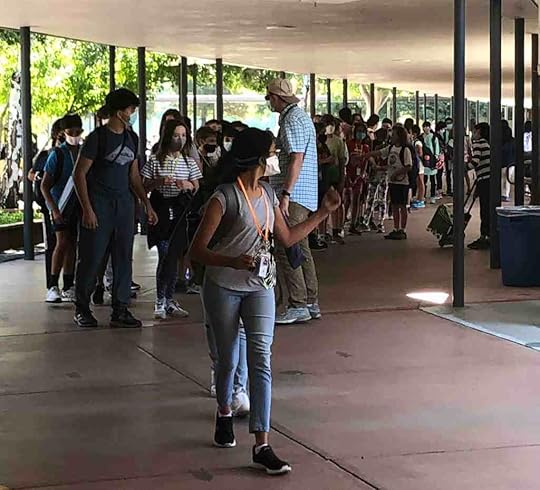 The students queuing up to come into the library at lunch. I know how many there are every day because lunch is long enough that the district’s contact tracing requirements mean we have to keep track of who comes in. Fortunately they all wear badges with unique barcodes, so we can simply scan their badges as they walk in the door. (Photo: Shala Howell)
The students queuing up to come into the library at lunch. I know how many there are every day because lunch is long enough that the district’s contact tracing requirements mean we have to keep track of who comes in. Fortunately they all wear badges with unique barcodes, so we can simply scan their badges as they walk in the door. (Photo: Shala Howell)There is a lot of anxiety bubbling out of the average student who walks through our doors. I don’t know how it compares to previous years, but almost every middle schooler I deal with feels like they are just a few cracks away from breaking.
Of the 70-odd students who come to the library every day at lunch, at least 10 bring some sort of fidget with them. Others repurpose stuff they find in the library like the pencils on our supply table, checkers from our Connect 4 games, and our perpetually incomplete packs of playing cards into fidgets to keep their hands occupied at lunch. Still others bring Rubik’s Cubes from home.
After a while, I noticed that the kids with the Rubik’s Cubes would always be surrounded by other kids staring longingly at their Rubik’s Cubes and asking if they could have a turn. Sometimes the answer was yes. But sometimes there was friction.
We had a couple of Rubik’s Cubes lying around our house that we weren’t using, so I decided to bring them in and add them to the Games Shelf. They were immensely popular and lasted about two days before they wandered out of the library.
I was telling my brother about this, and he pointed out that I worked in a library. Just because we don’t bother to check out the other games on our Games Shelf didn’t mean we couldn’t check out the Rubik’s Cubes.
He convinced me to give it another try. So when a generous donor gave us a collection of 12 Rubik’s Cubes, I created a sign out sheet to track who borrowed them and when. Every day when the cubes roll out, I ask one of our student helpers to take the names and track whether the cubes actually come back. It’s working like a charm so far. Something about making kids write down their name makes them much better about bringing the cubes back when the bell rings.
 Our library’s collection of Rubik’s Cubes. It’s been several weeks now, and we still have them all. It feels like a miracle every single day. Thanks, Paul. (Photo: Shala Howell)
Our library’s collection of Rubik’s Cubes. It’s been several weeks now, and we still have them all. It feels like a miracle every single day. Thanks, Paul. (Photo: Shala Howell)Some of the kids who check out the cubes actually solve them. Others use them to learn how to solve them (my checkout station includes three simple solution guides a student found for me online). Still others use them to make pretty patterns. And then there are the final set, who just want something to hold and keep their hands busy during lunch. In other words, they’re being used as socially acceptable fidgets.
We’ve only had one break so far, but fortunately, another student had already volunteered to be my Cube Repairman. I messaged him the day it happened, and he stopped by after school to fix it for me.
I could go on, but…There’s a lot more I could tell you, but hopefully this gives you a tiny taste of what life is like for me these days. Come to my library for the books if you like, but if you’d rather not, you could just play games, draw, flip through magazines, help make the library better, catch up on homework, or chat with your friends. We aren’t that into the Silence in the Library thing here at Fletcher. That said, if you’d rather run or climb, I will ask you to take a break outside.
See you around the stacks.
September 17, 2021
Book Review: Better with Books by Melissa Hart
NOTE: This post contains affiliate links to Bookshop.org, an online bookstore that provides financial support to local, independent bookstores. By the time I wrote this post, Bookshop.org had already raised $15.8m for local bookstores. If you use the links in this post to purchase a book or two on Bookshop.org, I’ll earn a commission on your book purchase, as will your preferred independent bookshop. You can also find a selection of these books in the Caterpickles Bookstore. Regardless of whether you use my links or visit the Caterpickles Bookstore, I’m glad you spent part of your day reading Caterpickles. Learn more about Affiliate Links, the Caterpickles Bookstore, and why I decided to become a Bookshop.org Affiliate.
Better with Books by Melissa Hart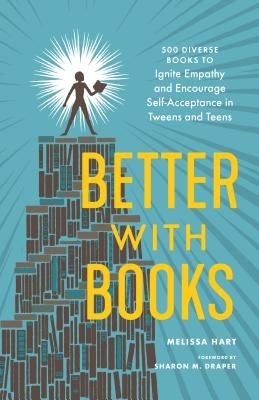
Genre: Reference
Publisher: Sasquatch Books
Year Published: 2019
Format: Paperback
Source: Purchase
My Rating: 




My Review: 




Growing up, younger me was blessed with not one, but two Book Aunts, who had the most marvelous taste in books. Every Christmas, my Great-Aunt Marian and my Aunt Jeanne used to send beautiful editions of books like King Arthur and the Knights of the Round Table, Charlotte’s Web, and The Illustrated Treasury of Poetry for Children.
Their taste in books aligned so neatly with my own, that I would try to sneak off with my siblings’ books as well while the wrapping paper that had disguised them still littered the floor. My older brother quickly learned the intricate art of crafting traps that were just dangerous enough to protect his books without doing too much damage to me, but my sister shared a room with me and was forced to accept the fact that I would treat her books as my own. Fortunately, she didn’t mind that nearly as much as she minded sharing her socks.
Now that I’m a responsible adult with nieces of my own, I am doing my best to carry on the family’s Book Aunt tradition by sending my nieces books for birthdays and major holidays. At first it was easy. Picture books are so short, it’s trivial to read several in the bookstore before picking my favorites to wrap up and mail out. But now that three of my nieces are in middle school and high school, screening appropriate books before gifting them is much more time consuming. Frankly, I’m starting to struggle a bit, even with two voracious readers in the house ready and willing to help me. But that doesn’t mean I should just stop.
I don’t need to tell you how emotionally tender middle schoolers can be or how fraught with potential and stress the high school years can feel. The ability to see themselves in the books they read can be an invaluable source of comfort for tweens and teens. Reading a wide range of books can also help teens develop empathy and compassion for those whose stories aren’t their own. In many respects, my role as Book Aunt has never felt more important.
That’s where Melissa Hart’s Better with Books: 500 Diverse Books to Ignite Empathy and Encourage Self-Acceptance in Tweens and Teens comes in.
“The right book read at the right time can change a life, and that’s why Better with Books belongs in every library. Timely, compassionate, and wise, this is a remarkable reference guide.”
Katherine Applegate, Newbery Medal award-winning author of The One and Only Ivan.
Better with Books includes reading guides on a variety of topics:
AdoptionBody ImageImmigrationLearning ChallengesLGBTQIA+Mental HealthEnvironmentPhysical DisabilitiesPovertyRace / EthnicityReligion and SpiritualityHart’s reading lists are divided into sections for tweens and older teens. She provides a brief summary of each book that succinctly describes the setting, point-of-view character, main issues, and genre. Published in 2019, Better with Books obviously doesn’t include the absolute latest publications, but there are still plenty of relevant and engrossing titles in it that I see the kids at my middle school devouring daily, such as Al Capone Does My Homework by Gennifer Choldenko (Learning Challenges), Counting by 7s by Holly Goldberg Sloan (Adoption/Foster Care), and Brave by Svetlana Chmakova (Body Image). Hart’s lists are detailed enough to make it easy for parents, teachers, librarians, and book aunts/uncles to find at least one book that would appeal to every reader on their list.
I find this book so useful, I’m planning to keep my copy of it at the circulation desk to refer to when the students ask me to help them find their next great read. Marked up, of course, because this is a book meant to be used, not just read.
 My copy of Better with Books, all marked up and ready for its debut at the circulation desk on Monday morning. In addition to the color tabs marking each list, I’ve highlighted in yellow the books already in our library’s collection for easy reference. (Photo: Michael Howell, who kindly framed it to include my other weekend project, a BB-8 blanket based on the pattern in
Stars Wars: Knitting the Galaxy
.) What about you?
My copy of Better with Books, all marked up and ready for its debut at the circulation desk on Monday morning. In addition to the color tabs marking each list, I’ve highlighted in yellow the books already in our library’s collection for easy reference. (Photo: Michael Howell, who kindly framed it to include my other weekend project, a BB-8 blanket based on the pattern in
Stars Wars: Knitting the Galaxy
.) What about you? What have you been reading lately?
Related Links:
Book Review: What the Night Sings by Vesper Stamper (Caterpickles)
September 12, 2021
Some personal news… Update
As I mentioned last month, I spent August working as a long-term substitute in my local middle school library. Turns out, I really love spending my days this way. So I applied for the job, and they decided they liked me well enough to keep me on. Which I guess means for the first time in almost fifteen years, I’ll have to stop describing myself as a full-time writer and start describing myself as a part-time middle school library assistant and writer. Honestly, that suits me just fine.
As a practical matter, this likely means that in addition to the usual fare of book reviews and fun but impractical research here on Caterpickles, I’ll start writing about topics inspired by my experiences in a middle school library. For obvious reasons, I won’t be writing about the students themselves beyond generic references to the books I see them reading or the types of books they ask me to find. But I am planning to write very freely about the books I find buried in the stacks and the questions they raise about how we think about ourselves and our histories.
August 27, 2021
Book Review: In the Name of the Family by Sarah Dunant
NOTE: This post contains affiliate links to Bookshop.org, an online bookstore that provides financial support to local, independent bookstores. By the time I wrote this post, Bookshop.org had already raised $15.3m for local bookstores. If you use the links in this post to purchase a book or two on Bookshop.org, I’ll earn a commission on your book purchase, as will your preferred independent bookshop. You can also find these books in the new Caterpickles Bookstore. Regardless of whether you use my links or visit the Caterpickles Bookstore, I’m glad you spent part of your day reading Caterpickles. Learn more about Affiliate Links, the Caterpickles Bookstore, and why I decided to become a Bookshop.org Affiliate.
In the Name of the Family by Sarah Dunant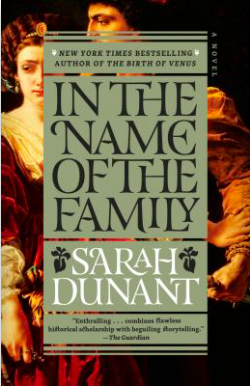
Genre: Historical Fiction (Adult)
Publisher: Random House Trade
Year Published: 2018
Format: Paperback
Source: Purchase
My Rating: 



My Review:“It is 1502 and Rodrigo Borgia, a self-confessed womanizer and master of political corruption, is now on the papal throne as Alexander VI. His daughter Lucrezia, aged twenty-two–already three times married and a pawn in her father’s plans–is discovering her own power. And then there is his son Cesare Borgia, brilliant, ruthless, and increasingly unstable; it is his relationship with Machiavelli that gives the Florentine diplomat a master class in the dark arts of power and politics. What Machiavelli learns will go on to inform his great work of modern politics, The Prince. But while the pope rails against old age and his son’s increasingly erratic behavior, it is Lucrezia who must navigate the treacherous court of Urbino, her new home, and another challenging marriage to create her own place in history. Sarah Dunant again employs her remarkable gifts as a storyteller to bring to life the passionate men and women of the Borgia family, as well as the ever-compelling figure of Machiavelli, through whom the reader will experience one of the most fascinating–and doomed–dynasties of all time.”
From the book description on Bookshop.org




This book took me a while to read because it demanded more of my attention than I could give it when I started it back in January 2020, for various reasons. Also, one of the characters contracts an essentially untreatable (at the time) illness partway through the book, which was a bit too much for me in the pre-vaccination times of the COVID-19 pandemic.
However, it’s a testament to how vividly Dunant draws these characters and this period of history that I could set this book aside for 18 months, pick it up again last week, and immerse myself in the story without feeling like I had been dumped into the company of strangers or forgotten where I was in the plot.
This was my first Dunant. I picked up because I had seen several reviews calling her one of the best historical fiction writers of our time, and I wanted to see what all the fuss was about. It won’t be the last.
What about you?What have you been reading lately?
Related Links:
Book Review: What the Night Sings by Vesper Stamper (Caterpickles)



